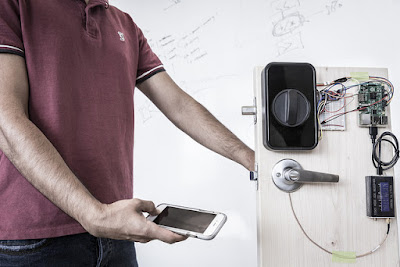Scientists have devised a way to
send passwords through the human body rather than over airborne radio waves
like Wi-Fi or Bluetooth which are vulnerable to hacking. University of
Washington computer scientists and electrical engineers have devised a way to
send secure passwords through the human body using benign, low-frequency
transmissions generated by fingerprint sensors and touchpad’s on consumer
devices. If you want to open a door using an electronic smart lock, you can
touch the knob and touch the fingerprint sensor on your phone and transmit your
credential through your body to open the door, without leaking the personal
information over the air.
Sending a secret code over radio
waves like Wi-Fi or Bluetooth means anyone can eavesdrop. Fingerprint sensors
have so far been used as an input device. They have shown for the first time
that these sensors can be re-purposed to send out information confined to the
body. The process employs a sequence of finger scans to encode and transmit
data. The team achieved rates of 50 bits per second on laptop to touchpad’s and
25 bits per second with fingerprint sensors – fast enough to send a password or
code through the body and to a receiver within seconds. In tests with 10
different subjects the researchers were able to generate usable on-body transmissions
on people of different height, weight and body types.
The system also worked when
subjects were in motion. They showed that it works in different postures, like
standing, sitting and sleeping. They can also get a strong signal throughout
your body. The receivers can be anywhere – on your leg, chest, hands, - and
still work. Normally, sensors use these signals to receive input about your
finger. However, the engineers devised a way to use these signals as output
that corresponds to data contained in a password. When entered on a smartphone,
data that authenticates your identity can travel securely through your body to
a receiver embedded in a device that needs to confirm who you are. The technology
could also be useful for secure key transmissions to medical devices which seek
someone’s identity before sending or sharing data.

No comments:
Post a Comment